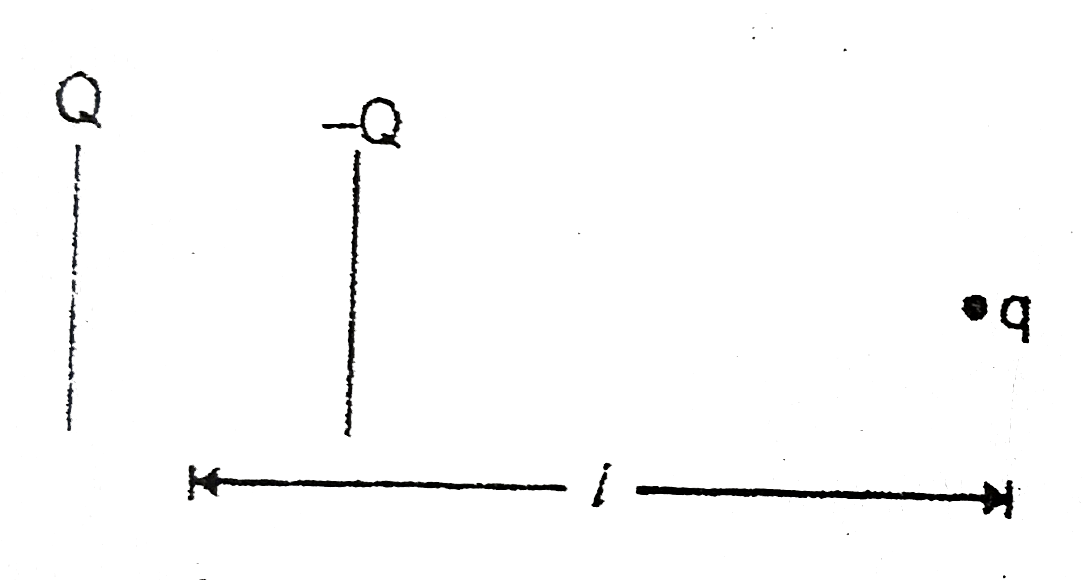The potential difference between two large parallel plates is varied as v = at, a is a positive constant and t is time. An electron starts from rest at t=0 from the plate which is at lower potential. If the distance between the plates is L, mass of electron m and charge on electron -e then find the velocity of the electron when it reaches the other plate.
To solve the problem, we will follow these steps:
Step 1: Determine the Electric Field
The potential difference V between the plates is given by V=At. The electric field E between the plates can be found using the relation:
E=−dVdx
Since the potential difference is changing with time, we can express the electric field as:
E=dVdt=d(At)dt=A
Thus, the electric field E is constant and equal to A.
Step 2: Calculate the Force on the Electron
The force F acting on the electron due to the electric field is given by:
F=qE
where q is the charge of the electron, which is −e. Therefore, the magnitude of the force is:
F=−eA
Step 3: Determine the Acceleration of the Electron
Using Newton's second law, the acceleration a of the electron can be expressed as:
a=Fm=−eAm
Since we are interested in the magnitude, we can write:
a=eAm
Step 4: Relate Acceleration to Velocity
The acceleration is defined as the rate of change of velocity:
a=dvdt
Substituting the expression for acceleration:
eAm=dvdt
Step 5: Integrate to Find Velocity
We can integrate both sides with respect to time to find the velocity v:
∫dv=∫eAmdt
This gives:
v=eAmt+C
Since the electron starts from rest at t=0 (initial velocity v(0)=0), we find that C=0:
v=eAmt
Step 6: Find the Time Taken to Travel Distance L
To find the time t it takes for the electron to travel the distance L, we can use the kinematic equation:
L=12at2
Substituting for a:
L=12(eAm)t2
Rearranging gives:
t2=2mLeA
Step 7: Substitute Time Back to Find Velocity
Now, substituting t2 back into the velocity equation:
v=eAmt=eAm√2mLeA=√2eALm
Final Answer
Thus, the velocity of the electron when it reaches the other plate is:
v=√2eALm
The potential difference V between the plates is given by V=At. The electric field E between the plates can be found using the relation:
E=−dVdx
Since the potential difference is changing with time, we can express the electric field as:
E=dVdt=d(At)dt=A
Thus, the electric field E is constant and equal to A.
The force F acting on the electron due to the electric field is given by:
F=qE
where q is the charge of the electron, which is −e. Therefore, the magnitude of the force is:
F=−eA
Using Newton's second law, the acceleration a of the electron can be expressed as:
a=Fm=−eAm
Since we are interested in the magnitude, we can write:
a=eAm
The acceleration is defined as the rate of change of velocity:
a=dvdt
Substituting the expression for acceleration:
eAm=dvdt
We can integrate both sides with respect to time to find the velocity v:
∫dv=∫eAmdt
This gives:
v=eAmt+C
Since the electron starts from rest at t=0 (initial velocity v(0)=0), we find that C=0:
v=eAmt
To find the time t it takes for the electron to travel the distance L, we can use the kinematic equation:
L=12at2
Substituting for a:
L=12(eAm)t2
Rearranging gives:
t2=2mLeA
Now, substituting t2 back into the velocity equation:
v=eAmt=eAm√2mLeA=√2eALm
Thus, the velocity of the electron when it reaches the other plate is:
v=√2eALm
Topper's Solved these Questions
- ELECTROSTATICSBOOK - RESONANCE ENGLISHCHAPTER - ELECTROSTATICSEXERCISE - Part - II
23 Videos
- ELECTROMAGNETIC INDUCTIONBOOK - RESONANCE ENGLISHCHAPTER - ELECTROMAGNETIC INDUCTIONEXERCISE - A.l.P
19 Videos
- EXPERIMENTAL PHYSICSBOOK - RESONANCE ENGLISHCHAPTER - EXPERIMENTAL PHYSICSEXERCISE - PART -II
10 Videos
Similar Questions
In an electron gun, the electrons are accelerated by the potential V. If the e is the charge and m is the mass of the electron, then the maximum velocity of these electrons will be
View SolutionThe distnace between the plates of a parallel plate capacitor is 3 mm the potential difference applied is 3×105 V. If an electron travels from one plate to another the change in its potential energy is
View SolutionAn electron having charge e and mass m starts from the lower plate of two metallic plates separated by a distance d. If the potential difference between the plates is V, the time taken by the electron to reach the upper plate is given by
 .
.
View SolutionThe electric potential difference between two parallel plates is 2000V. If the plates are separated by 2 mm, then what is the magnitude of electrostatic force on a charge of 4×10−6C located midway between the plates ?
View SolutionThe plates of small size of a parallel plate capacitor are charged as shown. The force on the charged particle of 'q' at a distance 'l' from the capacitor is : (Assume that the distance between the plates is d<<l)

View SolutionThe plates of small size of a parallel plate capacitor are charged as shown. The force on the charged particle of 'q' at a distance 'l' from the capacitor is : (Assume that the distance between the plates is d<<l)

View SolutionThe force between the plates of a parallel plate capacitor of capacitance C and distance of separation of the plates d with a potential difference V between the plates, is.
View SolutionThe potential enery of a charged parallel plate capacitor is U0. If a slab of dielectric constant K is inserted between the plates, then the new potential energy will be
View SolutionThe potential enery of a charged parallel plate capacitor is U0. If a slab of dielectric constant K is inserted between the plates, then the new potential energy will be
View SolutionA parallel plate capacitor of plate area A and plate separation d is charged to potential difference V and then the battery is disconnected. A slab of dielectric constant K is then inserted between the plates of the capacitor so as to fill the space between the plates. If Q, E and W denote respectively, the magnitude of charge on each plate, the electric field between the plates (after the slab is inserted), and work done on the system, in question, in the process of inserting the slab, then
View Solution
